In the North Eastern part of Leyte, about 360 kilometers from Manila lies Tacloban City, the gateway to adventure east of Visayas. Not only do local and foreign visitors marvel at its pristine waters, they also take a tour of the past by visiting the historical structures located around the tourist circuit.
Progress, too, is evident here as it was proclaimed a highly urbanized city in December 2008 and a candidate for one of the top 10 Highly Urbanized City (HUC) Governments in 2011.Tacloban is the seat of trade, tourism, education, culture,and government in Region VIII.
Up until 2013, there was no way but up for the rapidly developing city. It was the stroke of fate in November of that year that changed the course of its history. Typhoon Yolanda, arguably the strongest typhoon ever that made a landfall in the world, greatly devastated Tacloban.
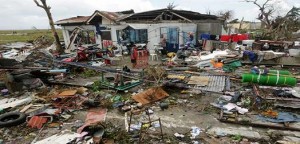
After ‘Yolanda’, the city was permeated with the stench of dead bodies. It had become a place wiped clean of shelter, livelihood, and urbanization.
“Amoy ngpatay, amoy ng mga survivors, amoy ng araw at ulan… amoy ng isang devastated na lugar ang Tacloban (The smell of the dead, the smell of survivors, Tacloban was the smell of devastation),” recalled Faye, one of the responders from the Department of Social Welfare and Development (DSWD)-Central Office (CO).
The birth of the new normal
Year 2013 would go down in disaster playbooks as the year of calamities for the country. Disasters, both man-made and natural, struck the Philippines one after the other, starting with the Sabah conflict in March that led to the displacement of many Filipinos, and then Tropical Storm Maring in August, the Zamboanga siege and Typhoon Santi in September, and the Bohol earthquake in October, and finally ‘Yolanda’ in November.
The Philippines is no stranger to frequent visits of natural disasters. It is, after all, lying within the Pacific Ring of Fire, an area where typhoons and earthquakes occur.
In the 2012 World Risk Report by the United Nations University Institute of Environment and Human Security (UNU-EHS), the country was reported the third most disaster-prone country worldwide out of 173 countries assessed.
Every year, the Philippines is visited by an average of 20 typhoons per year, 5 of which are considered destructive.
An average of five earthquakes (though majority are too weak to be felt) also occur per day.
On November 2, news programs went abuzz over a low pressure area (LPA) that could possibly intensify and hit the Philippines in the following days. It only took two days for the LPA to intensify to a tropical storm according to the Japanese Meteorological Agency (JMA) and the Joint Warning Center (JTWC). As days passed, the storm progressed to SupertyphoonHaiyan, and on November 7, ‘Haiyan’, now bearing the local name ‘Yolanda’, entered the Philippine Area of Responsibility.
The Philippine Atmospheric, Geophysical & Astronomical Services Administration (PAGASA) issued public storm signal warnings and alerted people of a storm surge that would hit the coastal areas.
At that time, the country was still recovering from the aftermath of other disasters.
In Bohol, a total of P23, 373, 874 worth of relief goods were transported to Tagbilaran City via C-130 and Philippine Coast Guard (PCG) Ship. Some 198 personnel from DSWD-CO and Field Offices (FOs) were deployed to affected local government units (LGUs) to augment in disaster operations. Medical missions and clean-up operations were also being done alongside monitoring of ‘Yolanda’.
As the National Disaster Risk Reduction and Management Council (NDRRMC) and other agencies were putting things in order, they were also bracing for ‘Yolanda’.
Before the fateful day, NDRRMC had called for a meeting to reaffirm the status of preparedness of concerned agencies.
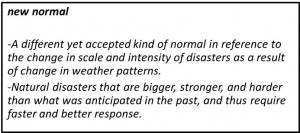 DSWD prepositioned 24,450 family food packs and downloaded funds amounting to P30 million to the regions that were along the path of the typhoon.
DSWD prepositioned 24,450 family food packs and downloaded funds amounting to P30 million to the regions that were along the path of the typhoon.
The LGUs installed disaster preparedness measures, making sure that their response teams would be easily alerted. Forced evacuation procedures were simultaneously executed.
Preparedness was done, and done very well.
Yet, even a well-executed disaster preparedness plan could not match the events that occurred.
In the afternoon of November 8, ‘Yolanda’s’ wrath, with rains and sustained winds of 300 kilometers per hour, was clearly evident.
People braced themselves for the howling winds, floods, and mudslides that commonly accompany this kind of storm. But ‘Yolanda’ had another unpleasant surprise for them.
As the winds became stronger, a storm surge as high as six meters barreled its way farther inland, causing rapid flooding and devouring everything that got in its path.
After the storm, power was down, trees uprooted, bridges collapsed, roads blocked, houses down, lives lost.
The Visayas Region bore the brunt of the disaster. More than three million families were affected, with less than one million displaced and about a million properties totally damaged.
Tacloban, the hardest hit, became a ghost town.
With the paralysis of the regional hub in Eastern Visayas, transportation, communication, and service delivery in neighboring cities and towns were also disrupted.
On said day, the “new normal” for disaster occurrences was born.
The difficult journey to Tacloban
Immediately after the disaster, office and bureau heads in the CO and FOs convened their staff to form the first batch of responders who will assist in the relief operations in Tacloban.
Secretary Corazon Juliano-Soliman, the Vice-Chairperson for Disaster Response, led the operations, getting aboard a C-130 cargo plane of the Philippine Air Force (PAF), together with NDRRMC Chief Eduardo del Rosario, and PAF Commanding General Lt. Gen Lauro Cruz, to assess the situation of the disaster-wrought province.
At the DSWD Central Office, volunteer-employees from different offices and bureaus got ready for deployment to Tacloban. Most of the responders were experienced in disaster response while others faced their baptism of fire. But experienced or first timer, nothing would prepare them for the state of devastation that would welcome them in Tacloban.
For DSWD-CO responders, all roads led to Tacloban after ‘Yolanda’, but none of those roads was easily passable for them.
“We were called the Journeying Team because of our difficulty in getting to Tacloban,” shared Glo, a responder from DSWD-Capacity Building Bureau (CBB), recalled.
The group had to wait for a commercial flight to get them to Cebu because there were very few planes heading to the place. After they landed in Cebu, they had to secure another means of transportation to Tacloban.
“Only the naval ship was available to take us to Tacloban. We rode alongside families and relatives of ‘Yolanda’ survivors. They wanted to go to Tacloban to take their families out of the place,” Glo mentioned.
When the group reached the city, they boarded a vehicle towards the DSWD Operations Center. The atmosphere was tense, with people starving and asking to be flown out of the city. Anyone who went to Tacloban for rescue and relief operations was hounded by requests for food from survivors.
Immediate relief ops
When the first batch of responders composed of staff from the DSWD-Disaster Risk Reduction and Response Operations Office (DRRROO) reached Tacloban, they immediately conducted assessment of the communities that needed relief.
Relief goods were given to heads of barangays for them to facilitate speedier distribution to people in their respective areas. The responders were on the field from 5 a.m. to 5 p.m.
Without electricity, disaster operations had to cease at night time.
In the morning, when the delivery of relief goods commenced, the responders boarded military trucks, escorting the soldiers who would deliver the goods from the warehouse to designated areas. Some of the goods had to be air dropped because there were towns that remained unreachable via land travel.
Jenny of CBB, aboard one of the helipads, recalled watching in awe as people pushed their way near the drop zone just so they would be the first ones to get the day’s delivery of goods.
Reporting on the status of incoming and outgoing of goods was also not a walk in the park. Glo narrated that a person manning the sea port had to walk from end to end just to provide updates on the status of incoming relief goods.
Faye, one of the responders manning the airport, recalled how the runway was converted to a storage space for incomingrelief goods to help ease operations in the warehouses in Tacloban.
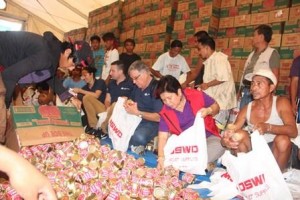
She noted that some of the goods had to be repacked to ensure that the distributed food packs are up to standard. At the time, each family food pack provided by DSWD for the ‘Yolanda’ survivors contained six kilograms of rice, eight sachets of coffee, eight packs of instant noodles, and six canned goods.
At the airport, too, was a long queue of people who wanted to get to Cebu or to Manila to seek temporary or permanent shelter.
“May mga nakapila na maliliit na bata, buntis. Nakapila sila, umulan o umaraw (Some of those in the queue were small children, pregnant women. They stayed there, rain or shine).”
Since getting out of Tacloban took some time, the responders invited some of the males queuing in the airports and those outside to participate in the Department’s Food-for-Work (FFW) and Cash-for-Work (CFW) programs to hasten transfer of goods from the hubs to the trucks that would deliver the goods to different areas. The survivors who rendered service were given food or cash.
In the Palompon warehouse, the DRRROO group ensured that 10,000 sacks of rice were repacked per day.
They noticed, as they were monitoring relief goods, that some of the food packs they received were wet and so cannot be distributed. Learning from this experience, the department later used container vans instead of barges to transport relief goods.
More than immediate relief
The deployed CBB staff knew that as social workers, they had to do more than assist in the daily operations. They were, after all, sent there for a specific reason, and that was to provide psychological first aid (PFA). They converted an unused tent to a temporary venue for the PFA.
“Ang PFA ay p’wedeng kahit simpleng tapik lang o simpleng pagtabi lang sa biktima. Hindi mo sila p’wedeng tanungin kung kumusta na sila dahil alam mo ‘yung nangyari sa kanila. Ang kailangan lang nila ay makakausap o mapapagsabihan ng nangyari sa kanila (PFA can be done even by a simple pat in the back or by simply sitting beside the victims. You cannot ask them if they are okay because you know what they‘ve been through. They only need someone to talk to about their feelings),” Faye relayed.
The smell of Tacloban after ‘Yolanda’ left a lasting impression on the CBB responders when they got home from their deployment. The stench of decomposing bodies and permeating smell of devastation served as a reminder of the great work still at hand.
“We survived our stay in Tacloban, but the work is still far from over,” Glo added.
The need for information is as important as the need for food
The Disaster Augmentation and Response Team (DART) of the DSWD-Information and Communication Technology Management Service (ICTMS) were deployed to Tacloban in the morning of November 9 to immediately install satellite data communication and emergency power for the communication needs of responders.
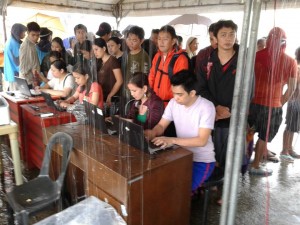
What the members of the team did not expect was that they would also help bridge the communication lines between ‘Yolanda’ survivors and their relatives in various parts of the country and abroad.
The installation of free internet service in the city hall provided survivors access to their email, Facebook, or Twitteraccounts wherein they were able to inform their relatives that they were alive or of their whereabouts.
For about five days, some 3,400 families, national and local government, humanitarian groups, and the media benefitted from the multi-modal emergency telecommunications support provided by the team.
The generators they brought also powered up the operations post and enabled survivors to charge their gadgets for 36 hours.
Alongside this provision of free service, rapid mapping was being done in disaster-hit areas.
On November 13, with the growing need to manage the inventory of relief goods, the satellite internet service was relocated to the DSWD warehouse in Barangay Apitong. This move ensured a more systematic monitoring of donated goods to aid in faster distribution.
Satellite phones from the Department of Science and Technology (DOST) were sent later for use of responders for disaster operations.
The DART continued manning the workstations for the communications and technology needs of the operations.
Understanding the new normal
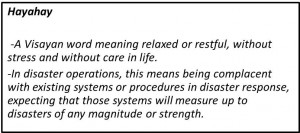 Sec. Soliman, in her message during the Post-Disaster Operations Review in Subic, narrated her encounter with a waiter who thanked her for what the department had done to survivors of ‘Yolanda’ in Tacloban.
Sec. Soliman, in her message during the Post-Disaster Operations Review in Subic, narrated her encounter with a waiter who thanked her for what the department had done to survivors of ‘Yolanda’ in Tacloban.
“Everybody knows that what we did in 2013 was phenomenal – nakatayo pa tayo, nakangiti, at patuloy na kumikilos (we are still standing, smiling, and continuing operations).”
Indeed, ‘Yolanda’, with the massive destruction it caused, presents a new challenge to disaster responders.
It went beyond the supertyphoon norm as the storm surge it triggered swallowed Tacloban whole, leaving only debris of the hard hit city.
At this stage, the new normal in disaster occurrences is only at its infancy. Recent studies show that the West Valley Fault is ripe for movement. If the fault moves and hence generates a strong earthquake, destruction would ripple not only in Metropolitan Manila, but also in the neighboring towns and cities.
What this means for the department is that there is a need to keep revisiting its preparedness and response plan under the lens of the new normal. There is a need to counter the “hayahay” mindset because as the Secretary puts it, “Ang binibigyan natin ng tulong ngayon ay kahapon pa kailangan ang tulong (The people we are helping now are those needing the help yesterday).”
Even as stronger, more destructive disasters occur, the Department will remain resilient and stay committed to leaving no one behind in its struggle against a different kind of ordinary.###


